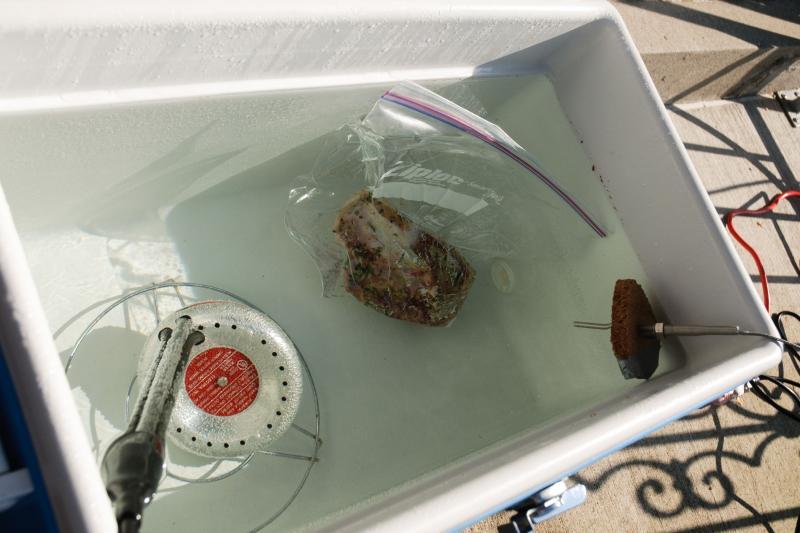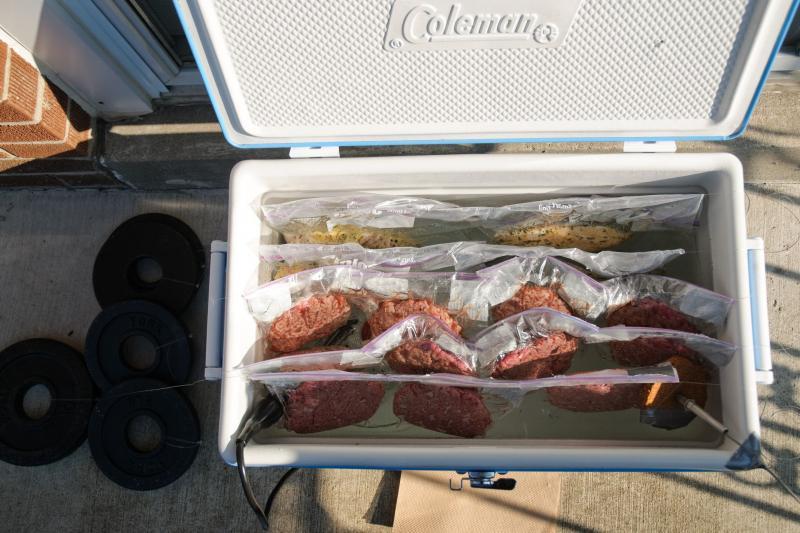
HowardLi
participating member-
Posts
433 -
Joined
-
Last visited
Content Type
Profiles
Forums
Store
Help Articles
Everything posted by HowardLi
-
Pretty much the only acceptable answer.
-
A bunch of 20x20 or 25x25 box fans with ultra-fine HEPA filters taped to their intakes.
-
Reference Thermometers and Calibration Methods for Cooking Sous Vide
HowardLi replied to a topic in Kitchen Consumer
Anybody aware of a good fast-response sensor that's easily soldered to wires? I want to use something other than an immersion probe for smoke temp. -
But what happens to the chicken?
-
Don't know, haven't seen it in person yet. The motor doesn't need to be that big to maintain speed.
-
What happens to a whole bird if it gets SVed right in the bath, i.e. direct contact with the water?
-
No, charcoal. The spit has an electric motor on it that will allow for constant rotation - hence the use of the word "rotisserie" in OP.
-
I was thinking of doing an equilibrium brine /w 1% and 0.4% wt/wt of salt and sugar respectively, but due to time constraints I expect to be able to brine only for about 12 hours depending on how long you guys think it will take to fully cook the pig. Should I increase the concentrations, and if so, by how much? Is it better to brine longer, or to cut the brine time even shorter (by an hour or two) to allow the pig to come closer to room temp?
-
I'll be receiving a 75-90lb pig tomorrow afternoon for use on Saturday. I know, it's later than I should've got it, but it's my friend's thing and his contacts all fell through. Anyway, assuming we want to start eating at a reasonable time on Saturday (say 7PM), what would be the best plan of action starting tomorrow? The pig will be drained, of course, but I am not sure if it will have some organs still attached. I do want to brine. The rotisserie is set up. Thanks
-
This may work, but for repeated visualization you have to add another few drops of ink again and again until the water gets too dark. I tried various corpuscles to continuously visualize convection currents: plastic snippets, short threads of cotton or Nylon, grains and seeds, all were either too heavy or too light; finally, with ground quinoa I succeeded, although it was not floating in perfect equilibrium. I used my FreshMealsMagic (2000W) in its transparent polycarbonate container without bubbling. While heating at full power, natural convection current was easily visible, but during steady state at 55°C (heating at about 110W), no significant convection current was visible. I turned the bubbler on for a few seconds to show the quinoa corpuscles moving; after stopping the bubbler movement subsided. My suspicion is that if 110W does not induce significant convection current, in a well insulated rice cooker or stock pot with a heat loss of less than 50W, there will be even less, i.e. practically no convection current. The videos are now on Youtube (in my earlier post of 10 July 2010 they were on www.mydrive.ch which requested login). On the other hand, steady-state heating will require much less fluid velocity in order to maintain the "same" uniformity.
-
Reference Thermometers and Calibration Methods for Cooking Sous Vide
HowardLi replied to a topic in Kitchen Consumer
The thermometer needs to be shaken down so that the temperature reading goes back to what it should be, right? Lot of Amazon reviews showing that the temp reading gets stuck. -
You could be right -- but since neither of us has done an A/B test to see if there is ACTUALLY no benefit. We don't know that it is an illusory benefit. Nathan has argued quite persuasively that there shouldn't be a benefit, but I wouldn't be adamant about how silly this guy's argument in until actually verifying that there is no benefit. Nathan's argument seems valid but I should also say that my neighbor (who gets to eat a lot of the sous-vide cooking that I do) has mentioned several times that on occasions when I took meat out of the cooker (such as tri-tip cooked at 133 to 135F) and it ended up waiting on the counter in its bag for a a while maybe 10 minutes before I got to removing it and torching it (usually because poor planning caused me to have to attend to something else for a few minutes) that he felt that the texture was better than the meat that went immediately from bath to torching. Now, I am skeptical that the 10 minute rest did anything -- but this has happened more than once -- and on at least one of these occasions there was some meat that didn't rest. So, it probably merits a few people coming up with an agreed upon protocol and performing it and seeing if it confirms what theory predicts. It probably will confirm no benefit to the food BUT I think it makes sense to do it before being too incensed. Anyway, that's my thought. Was your neighbor able to observe the process? That might've affected your findings.
-
I always leave it in auto-tune mode. I'll measure the overshoot I get next time but I don't think it's much.
-
If you do that once-in-a-life-time bathtub long duration sous vide, how about pouring vegetable oil on the water to prevent evaporation? You can recover all the oil later. dcarch I'm thinking it'll still bubble through. How about covering the surface with plastic film (not wrap)?
-
I did not measure the temperature variation throughout the cooler; I had other pressing issues to deal with. It certainly wasn't the worst case for temperature uniformity, though, since the meat was at the top and the heater at the bottom. I did have a pump but decided for some reason not to use it. Yes, everything was submerged.
-
It says 62.5 because that's what I had set it to before I double-checked my F to C calculations.
-
Some action shots I have to apologize for the size of the one that shows me with a beer, it seems the aspect ratios are not all done uniformly lol
-
Halogen lights would certainly work as a heat source. Even a bunch of incandescent ones would work. Longevity is questionable due to carbon buildup on the outside of the bulb (and potential hot-spotting). However, the advantage to using an electric burner is that you can easily smoke using wood chips.
-
I have a 40A relay because that's what was in stock at my local electrical supply store. If I had my druthers I'd be using a 25A unit from eBay for 1/3 the cost. Those too are zero-switching. I don't know that it makes a big difference, though, unless it plays funny with the GFCI - a resistive heating element certainly doesn't care. The probe is a through-tank style, with a ~4" cylindrical probe body welded to a 1/4" NPT fitting, with a coiled wire bend relief for the cable. Exactly the same as this one: http://cgi.ebay.ca/Thermocouple-Temperature-Control-Sensor-Probe-PT100-1m-/360370037493?pt=LH_DefaultDomain_0&hash=item53e7ba62f5 For hot air control, at steady-state I should think the Pt100 would do well, but I'll admit there is a lot of thermal mass for the air to heat up. I'll have to give it a shot as is, and if the response is too sluggish (and ends up causing oscillation) I would have to go with a smaller element meant for air. As I said before, the float is simply a disc of cork that the probe is inserted into. I can let it float around or I can secure it in place. As long as it isn't too far away from the food, it'll give a good reading. The PID is fine. It's easy to use and has a great auto-tune. Build quality is unquestionable.
-
I think the next thing I need to do is to set up a smoking rig. Apparently a cardboard box loses enough heat such that a 1000W burner cannot achieve temps of over ~200F - I'll have to see what I can scrounge up to make a reliable smoker.
-
Was it perfect? If not, what would you have improved?
-
Just realized I didn't tag the OP properly. I wonder if this will work sous vide SV cooker system controller temperature probe sensor PID calibrate submersible immersion heater relay pulse width modulation pwm resistance accuracy precision tune tuning auto automatic plastic bag ziploc zip-loc vacuum zip-lock ziplock npt fitting offset lol
-
What's wrong with it? These are fairly simple beasts - in fact the worst part is probably getting the sensor to read accurate temps, IMO.
-
1) The heat sink is not optimally positioned, no, but the relay can handle a lot of heat before de-rating its current handling. Moreover, even if the current handling was de-rated due to temperature, the relay starts off at 40A (forty!), which is 4 times what I need. If you flipped the heat sink around, it would be better, but the relay would then be much more difficult to maintain. I suppose I could have stood the heat sink on its end, but it really wouldn't have made a big difference, and the heat sink is now permanently affixed; I used 2-part epoxy to glue it to the inside of the panel. 2) No. The heat sink only gets warm (the relay has a very low cycle time at steady-state anyway). If anything, the internal wiring between the probe connector and PID is too close to the AC wiring, which may be inducing voltage (error) into the circuit, but since the probe has a good steady-state reading, I'm not worried about it.





